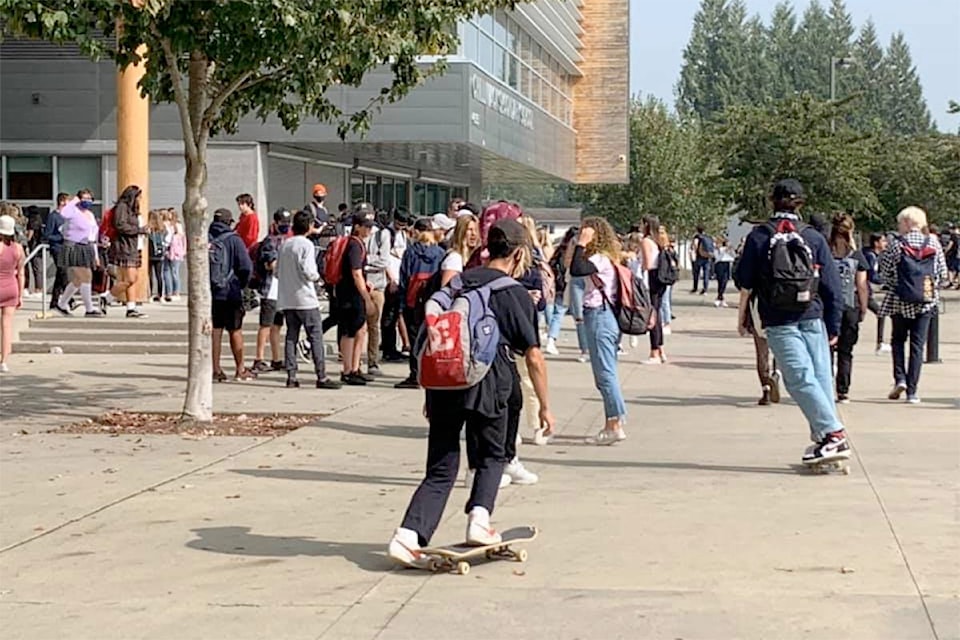Health Minister Adrian Dix repeated the “stick-to-six” slogan at the daily COVID-19 briefing a week ago, a reference to the public health recommendation on how many people should be in any given pandemic bubble.
If, however, you are having a public gathering or hosting an event, then 50 is nifty. Heading to school? Thirty is OK, too.
Last Thursday (Sept. 10) was the first day back in school for thousands of British Columbian kids, and that first day of school coincided with a record-high 139 new daily COVID-19 cases reported.
Not good.
• READ MORE: B.C. sets single-day record with 139 new COVID-19 cases
There are almost as many opinions about how to deal with school during a global pandemic as there are kids in school.
What is certain is that easing up on the good work done in this province in April and May, which led to fewer cases in B.C. than many other jurisdictions, will lead to bad outcomes for immune-compromised individuals, including some of the grandparents of those kids back in school.
What is also certain is that social isolation and living in near-lockdown conditions is not good for anybody. Experts say – and it’s obvious as parents – that children need social interactions, they need to connect with peers, and kids need to get back to school.
But complex political and social issues force decision makers to find a balance between extreme positions, competing interests and, in this case, evolving science. We need to protect our children. Our kids need to go to school. We need to protect the vulnerable in our communities. We all need to stay sane and connected.
What concerns me at this point is not the logic surrounding the decisions being made by Dr. Bonnie Henry and other public health officials or our elected representatives. I accept the nuance and complexity behind what we are being told about masks and who should wear them and when, about two metres and a shift to one-metre distancing, about groups of 50 or 30 or six being OK.
What concerns me is that complexity is often interpreted as mixed messaging, and many adults are spreading falsehoods about the pandemic, sowing ever more confusion. And children and teenagers do not always make the best choices.
Kids often either wilfully or absent-mindedly disobey orders from parents and other adults. So what are the chances that we will see good compliance from school-aged kids if the advice from adults is complicated at best, mixed messaging at worst?
I walked to the grocery store after the first day of school and saw a group of about 25 high-school kids hanging out in a small park, skateboarding and chatting. Not far away in a public place was a group of about a dozen middle-school-aged kids, similarly hanging around in close quarters.
Notwithstanding siblings, each and every one of those young people represent a different household, each of which has its own dynamics, ages of parents and grandparents, connections to extended family. And health issues? While a group of 25 teenagers in close proximity talking and laughing may seem irresponsible, those same teenagers were sent to a school classroom that same day in a group of as many or more.
COVID fatigue is real, and as the summer draws to a close we saw more and more people in the under-35 demographic gathering in large numbers at house parties, on beaches, on local trails. With an increasingly complex public health message sent out by our leaders, and irresponsible behaviour from adults of all ages in locations such as nightclubs, I ask again, what hope do we have that our children will model the type of behaviour needed to get this pandemic under control?
The relaxed attitude in some circles along with back-to-school confusion will almost certainly lead to a true second wave, beyond the “ripple” Dr. Henry reported we were seeing earlier last week.
Many parents are worried. Most teachers are worried. Just about all immune-compromised people are terrified.
It’s not a stretch to conclude that this situation is likely to get worse before it gets better.
• READ MORE: COLUMN: The call for full-scale economic reopening is an argument to cull the herd
Do you have something to add to this story, or something else we should report on? Email:
paul.henderson@theprogress.com
Like us on Facebook and follow us on Twitter.
Want to support local journalism during the pandemic? Make a donation here.
